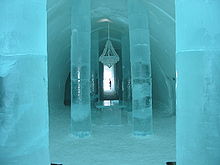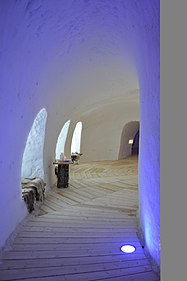Ice hotel
An ice hotel is a hotel that is built from snow and ice in autumn and serves as a tourist attraction over winter. Locations can be found in Fennos Scandinavia as well as in North America ( Alaska , Canada ) and Austria .
history
The Ice Hotel in Jukkasjärvi is the oldest ice hotel in the world. In 1989, on the initiative of the local tourism association, an exhibition with ice sculptures by Japanese artists was brought to life. In 1990, an art exhibition by Jannot Derid was shown in a cylindrical igloo called Arctic Hall on the ice of Torne älv . Some guests spontaneously spent the night in the hall - with warm sleeping bags on reindeer skins . In 1991, buildings made of snow and ice were built as hotels for the first time. The complex included a lobby, bar and bedrooms. In the next few years it was constantly enlarged and expanded with a church and a cinema. In 2003 the ice hotel was expanded to include an ice theater: classical plays are staged in the replica of the Globe Theater .
The ice hotel in Jukkasjärvi has around 60 rooms in addition to the ice bar and entrance hall, which can accommodate 140 people. 30,000 tons of snow and 4,000 tons of clear ice are used for the construction. 14,000 overnight stays are booked every season - an additional 45,000 day visitors visit the facility.
construction
Construction of the hotel begins at the end of October each year. With wheel loaders and snow cannons , snow is applied to steel formwork, which can be removed after two days. With this type of construction, several tunnel-like pointed arches are built next to each other . The largest is 5 meters high and 6 meters wide, it is also supported by pillars made of ice blocks. It houses the entrance hall and the bar. Further smaller tunnels are being built for the bedrooms and corridors. The boundaries of space within the tunnels are walled up with blocks of snow, the windows are formed by clear blocks of ice.
The interiors of ice hotels are decorated with illuminated sculptures and objects made of ice. The 4,000 tons of ice obtained (in 2-ton blocks) are stored in a cold store over the summer .
In contrast to construction technology with steel formwork, large balloons are sometimes snowed in with the help of snow blowers . The snow used is particularly moist snow, which freezes after a certain time due to the prevailing temperatures. As soon as the snow has solidified on the balloons, the balloons can be removed again and the individual IGLOOs and numerous connecting passages are created.
overnight stay
You can stay in the hotel from mid-December to mid-April. The inside temperature is around –5 ° C, with outside temperatures around –30 ° C. The guests usually spend only one night in the ice hotel and the remaining nights in nearby huts. Padded snowmobile overalls protect against the cold . You sleep in sleeping bags on reindeer skins, which are also separated from the ice blocks by a board and a mattress. During the day, the rooms in the ice hotel are open to all visitors, but from the 2013/14 season it will be possible to book private suites. Offered außerdeme dog sledding , snowshoeing and a visit to a moose farm .
Surroundings
The area around ice hotels is often shaped by tourists and known for its breathtaking nature and biodiversity, but also for culture. The winter season in the vicinity of ice hotels is long and sometimes extreme weather conditions prevail. This also creates the best conditions for testing prototypes in extreme weather-related situations and for luring the automotive industry to the region's test tracks.
Ice bars
Ice bars or snow bars are designed according to the same concept . They are bars that are built entirely from snow and ice. They are all temporary structures that are only built permanently for the winter season and are often integrated into ice hotels.
The snow bars can be found as independent catering establishments in the ski areas of the Alps from the later 20th century . An additional, simple bar has been set up in front of the mountain inns and snack bars, where the bar is completely piled up with snow. This has the advantage that the skiers, who are already weatherproof, can consume casually in full winter gear. The concept proved to be successful, which is why these bars were also increasingly set up for après-ski , i.e. the evening entertainment, in the valley towns as well. Snow and ice bars can now also be found in other areas at winter sports facilities and other winter-related open-air events.
With the development of the snow / ice hotels, the ice bar was further developed into an entire room in the sense of a hotel bar or an independent restaurant .
Today ice bars are often artistically crafted and equipped with special light effects and special devices.
literature
- Jonathan Lee: 50 great adventures. Special places and the people who created them . Munich: Prestel Verlag, 2006. ISBN 3-7913-3530-8 .
Web links
Individual evidence
- ↑ Lapland has the oldest ice hotel in the world: sleep in the freezer. Retrieved June 26, 2020 .
- ^ Hans H. Hinterhuber: Customer management as a success factor: Basics of tourism marketing. Volume 1 of publications on tourism and leisure , Erich Schmidt Verlag 2004, ISBN 978-3-503-0781-89 , p. 97.
- ^ Bethan Ryder: New Bar and Club Design. Laurence King Publishing 2005, ISBN 978-1-856-6942-92 , p. 5.




